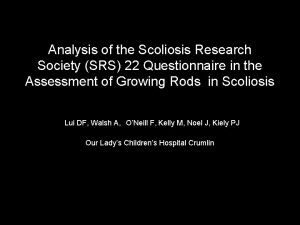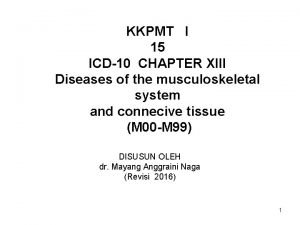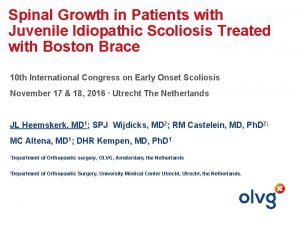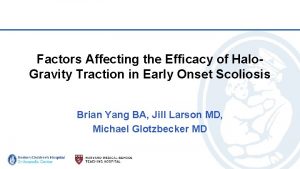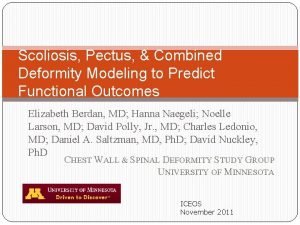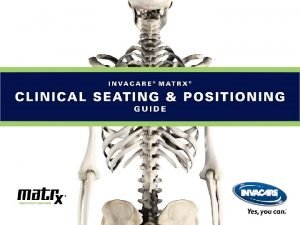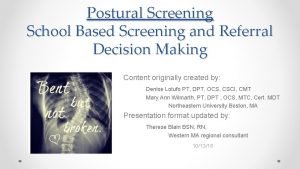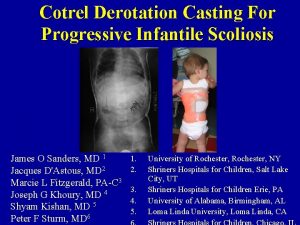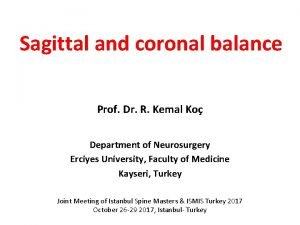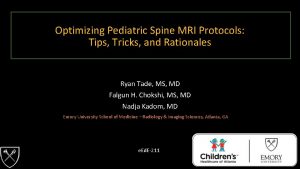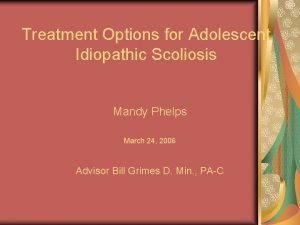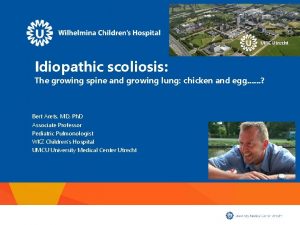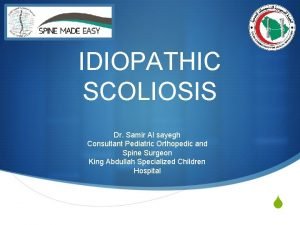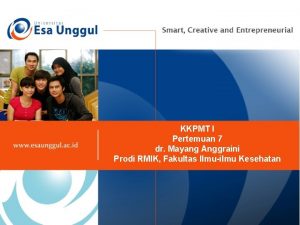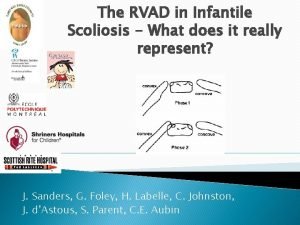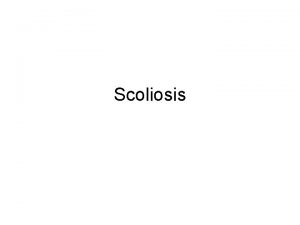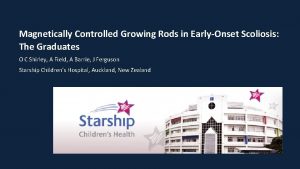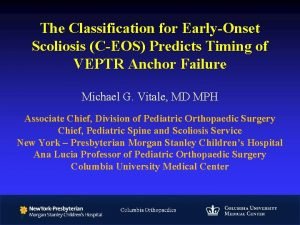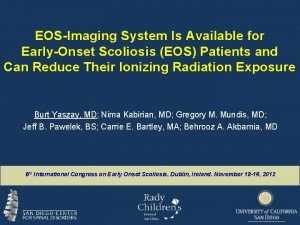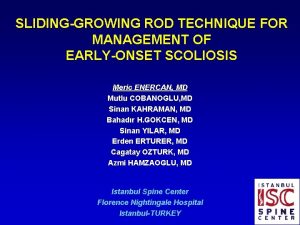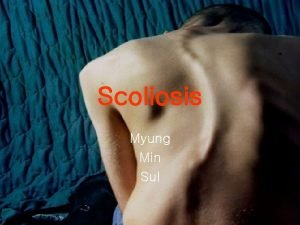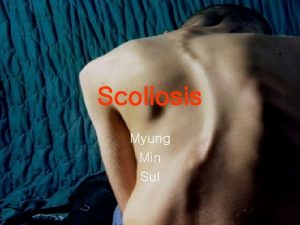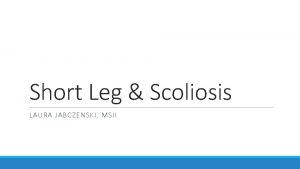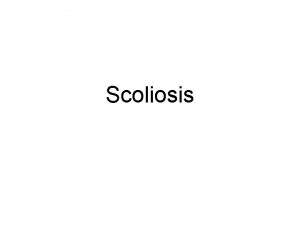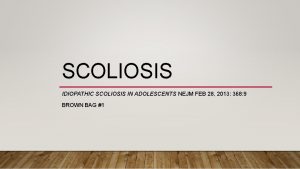Definitive Fusion in 12 Earlyonset scoliosis with Growing
















- Slides: 16

Definitive Fusion in 12 Early-onset scoliosis with Growing Rod National Hospital Organization Kobe Medical Center Teppei Suzuki, Koki Uno, Hiroshi Miyamoto, Yoshihiro Inui,

Introduction EOS (Early-onset scoliosis) Severe deformity Life threatening health risk TIS (Thoracic insufficiently syndrome) Campbell; JBJS, 2003 Davies; Arch Dis Child, 1971 Limited Fusion (Apical fusion, wedge resection, etc) Fusionless treatment VEPTR (Vertical expandable titanium rib) Shilla Growing Rod

Purpose Retrospetive case review of 12 children graduated dual growing rod at a single institution.

Objects Idiopathic No. of patients Gender (F: M) 12 8: 4 Age at initial surgery 10. 2± 4. 2 y. o. Duration between lengthenings 4. 0± 2. 6 yrs Congenital Neuromuscular Syndromic 3 3

Operative Tequnique Upper Foundation Extended Tandem connector submuscular Lower Foundation T 1 -3 Claw hook Cantilever Technique T 12 -L 3 Pedicle screw

Measurement Preinitial Postinitial Prefinal Postfinal Major Curve Kyphosis (T 1 -5 T 5 -12) T 1 -S 1 Length Lung Space Concave & Convex Complications Autofusion Final f/u

Main Curve Degree No. of lengthening 6. 0± 3. 8 130 90 98 Total Correction Rate 54 57± 26% 59 50 41 Initial Correction Rate 10 37 42± 13% Preinitial Postinitial GR Prefinal Postfinal Fusion FFU

Thoracic Kyphosis Degree No. of lengthening 6. 0± 3. 8 80 59 27 40 3 0 Preinitial 10 Postinitial 31 16 Prefinal 29 30 T 5 -12 19 T 1 -5 11 Postfinal FFU

Length of Elongation No. of lengthening 6. 0± 3. 8 mm 80 40 mm Concave 27 40 43 37 20 21 12 0 Initial Growth T 1 -S 1 Length 25 Convex 0 Initial Growth Lung Space

The Detail of the Complications 19 complications 72 lengthenings Hook Dislodgement Rod Breakage Screw Loosening / Pull-out Superficial Infection Deep infection Neurological Deficit 4 7 2 2 4 0

The Detail of the Complications With a minimum of one complication 8 patients (67%) 12 patients Complication rate per lengthening in each patient 23. 0± 20%

Autofusion Yes No No. of patients 7 5 Age at initial op (y. o. ) 9. 6± 4. 2 11± 0. 7 N. S. Interval (mo) Complication rate(%) Duration of the treatment (y) No. of lengthening per patient 8. 4± 2. 5 23± 20 8. 8± 1. 7 22± 22 N. S. 5. 3± 2. 5 2. 3± 0. 6 0. 02 7. 9± 3. 5 3. 4± 1. 7 0. 02 8. 0± 1. 8 13± 4. 8 0. 03 T 1 -S 1 elongetion per year (mm) P Value

Review (1) Our study Whole series Graduates No of cases Complication rate with min. 1 Complication rate Per Op 39 12 77% 67% 23% 140 13 58% 46% 18% 31 55% Akbarnia, et al. ; Spine 2008, JBJS 2010 Whole series Graduates Emans, et al. ; Spine 2005 VEPTR

Review (2) During between Cahill; Spine, 2010 No of cases lengthening Dual rod Autofusion rate 9 cases 9. 6 ys 89% 12 cases 4. 1± 3. 0 ys 58% This study Dual rod Longer duration of treatment Increasing no. of lengthening Shorter T 1 -S 1 elongetion per year Auto fusion?

Conclusion The dual growing rod maintains correction obtained at the initial surgery. Lengthening allowed the thoracic cage growth. Complication rate per lengthening was 23%. Autofusion rate was 58%. T 1 -S 1 elongation was significantly shorter in the autofusion group.

References 1. Akbarnia BA, Breakwell LM, Marks DS, et al. Dual growing rod technique followed for three to eleven years until final fusion: the effect of frequency of lengthening. Spine 2008 Apr 20; 33(9): 984 -90. 2. Bess S, Akbarnia BA, Thompson GH, et al. Complications of growing-rod treatment for early-onset scoliosis: analysis of one hundred and forty patients. J Bone Joint Surg Am. 2010 Nov; 92(15): 2533 -43. 3. Cahill PJ, Marvil S, Cuddihy L, et al. Autofusion in the immature spine treated with growing rods. Spine. 2010 Oct 15; 35(22): E 1199 -203. 4. Thompson GH, Akbarnia BA, Campbell RM Jr. Growing rod techniques in early-onset scoliosis. J Pediatr Orthop. 2007 Apr-May; 27(3): 354 -61. 5. Yang JS, Mc. Elroy MJ, Akbarnia BA, et al. Growing rods for spinal deformity: characterizing consensus and variation in current use. J Pediatr Orthop. 2010 Apr-May; 30(3): 264 -70. 6. Yazici M, Emans J. Fusionless instrumentation systems for congenital scoliosis: expandable spinal rods and vertical expandable prosthetic titanium rib in the management of congenital spine deformities in the growing child. Spine 2009 Aug 1; 34(17): 1800 -7
 Scoliosis research society
Scoliosis research society Disorder of synovium and tendon
Disorder of synovium and tendon Scoliosis chiropractor seminole county
Scoliosis chiropractor seminole county Scoliosis chair
Scoliosis chair Rib hump scoliosis
Rib hump scoliosis Wheelchair backrest for scoliosis
Wheelchair backrest for scoliosis Infantile scoliosis casting
Infantile scoliosis casting Postural screening worksheet
Postural screening worksheet Derotation cast
Derotation cast Coronal balance
Coronal balance Mri scoliosis protocol
Mri scoliosis protocol Costodesis
Costodesis Scoliosis
Scoliosis Turnbuckle cast scoliosis
Turnbuckle cast scoliosis Dr abdullah sayegh
Dr abdullah sayegh Disorder of synovium and tendon
Disorder of synovium and tendon Rvad angle
Rvad angle
